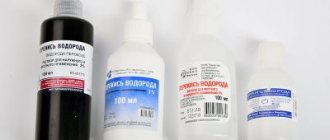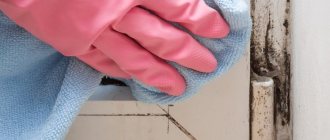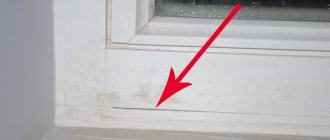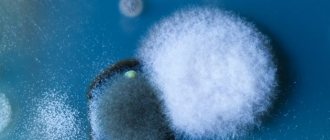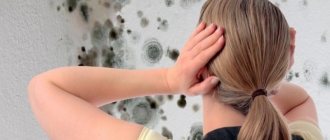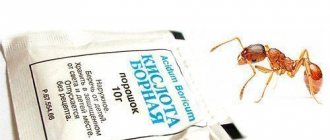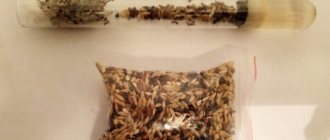Mold in the bathroom is a common occurrence that many have probably encountered. There can be many reasons for its appearance, but the main one is high humidity. Of course, its appearance will not please many people; it not only spoils the appearance of the walls of the room, but also has a harmful effect on health. Therefore, as soon as the first fungal stains begin to appear on the tiles in the bathroom, they must be immediately treated with special means. We will tell you in more detail how to clean mold on tile joints and what is used for this.
Causes of mold
Many people often ask why fungus often occurs in the bathroom? After all, it seems that everything is done to ensure cleanliness and order - cleaning, washing floors and walls, using special detergents. But fungal stains still appear again and again, and they cannot be cleared. First, it’s worth finding out the causes of mold:
- it is possible that when installing the tiles the relevant standards were not followed and mistakes were made;
- poor ventilation in the room;
- reduced temperature in the bathroom;
- poor quality cleaning of the premises;
- high level of humidity;
- Carrying out constant water procedures - drying things, washing.
Often, mold spots appear on tile seams, which greatly spoil the aesthetic appearance of the room. But do not forget that the fungus has a serious impact on health and can cause serious consequences. Therefore, when stains are first detected on the seams, treatment must be carried out immediately. For removal, you can use a special antifungal primer mixture. The seams are thoroughly wiped with a primer until the stains are completely removed. They can be covered with grout on the sealant.
In addition, the bathtub and toilet must be ventilated after taking a bath or shower or washing. To do this you need to open the door. It is advisable to install a fan in the ventilation duct to blow air into the room. Due to this, moisture will disappear faster.
It is good if the room has a hot heated towel rail or radiator. If these elements are missing, then a heater can be installed there to warm the room. It is also necessary to do cleaning using detergents that protect the tiles from fungal and mold stains.
Why does mold form?
To understand how to remove mold in tile joints, you need to understand the reasons for its appearance. No special conditions are required for the fungus to multiply.
Traces of mold in the bathroom
It only needs moisture. That is why the ideal place for the formation of mold colonies is the bathroom.
The decisive factors for this phenomenon include:
- poor ventilation, which contributes to the formation of moisture;
- leaking pipes and plumbing;
- drying wet laundry;
- cast iron pipes on which condensation forms;
- poor location of the bathroom, which contributes to the formation of excessive dampness;
- poor quality waterproofing of surfaces;
- lack of natural light (ultraviolet radiation destroys fungal spores).
In the old days, mold was an infrequent guest in residential buildings. Wooden windows and doors allowed air to circulate, providing good ventilation.
Therefore, people rarely thought about how to remove mold between tiles in the bathroom and other rooms.
The installation of plastic windows and sealed doors increased the sound insulation of the premises, but led to the formation of condensation, which caused extensive growth of fungus.
Places where mold stains occur
We seem to have figured out the reasons, now it’s worth finding out in what places spots of black or green fungus may appear. This will simplify the work and also save processing costs.
In the bathroom, fungal accumulations often appear in places:
- black or green spots often fill the seams of the tile covering;
- fungus may appear in the corners of the room;
- at the junctions of walls;
- Sometimes mold can be found in the shower stall, between the shelves, in any spaces between cabinets and walls.
Mold in the faucet area
Mold in the corner of the room
Basically, fungal spots appear in places with increased moisture accumulation. During the cleaning process, be sure to thoroughly wipe everything and check for mold stains.
Painting
Painting the joints between the tiles will help in two cases:
- The grout has turned black due to age or exposure to light;
- The dirt has embedded itself deep into the seams between the tiles.
Painting will not help against fungus and mold. Unless you first clean them and treat the surface with fungicides.
Suitable for cement-based grout:
- Acrylic paints “Fuga Fresca”, “Pufas Frishe Fuge Komplettset”;
- Polyurethane based paints (for concrete only);
- Latex paints (perform well under large temperature changes and do not crack).
All of the above paints have excellent adhesion and are abrasion resistant. When applying, follow the manufacturer's recommendations.
Water-based paints . Such compositions have a lot of advantages: environmental friendliness, high adhesion, affordable price, large selection of colors, quick drying. However, they are sensitive to moisture and wear out quickly, so they can be a temporary solution or followed by treatment with sealant, varnish or other transparent coating.
Markers . The optimal choice for small areas of contamination with the following advantages:
- Quick application and drying;
- Resistance to moisture;
- Environmental friendliness;
- Ease of use.
This option is acceptable if the length of the seams for cleaning is 5-10 m. Please note: use acrylic-based markers . This is an analogue of acrylic paint, but more convenient to use.
Advice
When choosing a paint composition, carefully study what surfaces it is suitable for. Please choose your color carefully: it may differ slightly from that stated by the manufacturer. A win-win option is white (refreshes, harmonizes with any color) or very dark (gives originality).
Ways to get rid of mold
Of course, the best way to get rid of mold and fungal stains is to prevent them from occurring. But if they do appear, then it is necessary to immediately begin cleaning them.
The grout between tiles can be cleaned in many ways. But before processing, it is necessary to prepare special mixtures for cleansing. The following products can be used against mold stains:
- household chemicals that contain chlorine. Household chemicals include “Belizna”, “Domestos” and products that contain chlorine. These mixtures are excellent helpers in the fight against mold. They not only remove it well, but also disinfect areas. In the future, mold spots do not appear in areas treated with chlorine-containing mixtures;
Household chemicals with chlorine
- special antifungal drugs designed to combat mold at home. One of these products is Polymix. This mixture contains a microbiocide in the form of quaternary ammonium. The drug has a destructive effect on all kinds of fungi, mold, pathogenic bacteria and microorganisms;
Polymix
- baking soda;
- alcohols and alcohol-containing compounds;
- antiseptic agents - hydrogen peroxide, potassium permanganate;
- products containing strong acids – acetic, oxalic;
- copper sulfate.
Folk remedies for mold
Mechanical method of removing fungus
Having discovered black spots in the room, the housewife usually takes a rag or a scraper, trying to wash off or scrape off the mold. To get an effective result, you need to know how to properly remove colonies of fungi in the bathroom.
First of all, detected areas of mold must be thoroughly moistened with water. This manipulation will prevent fungal spores from entering the air, which can cause new lesions.
Then you need to take a metal scraper or another similar tool (steel brush, drill with a grinding attachment), which will help thoroughly remove the affected area of the surface.
It is advisable to remove as much of the coating layer as possible (plaster, wallpaper, paint); For materials such as concrete and wood, milling is also possible.
In advanced cases, this method is not effective enough, since the mycelium can penetrate deeply even into inorganic surfaces, for example, hide under tiled cladding.
In this case, to solve the problem it will be necessary to carry out a major overhaul, including:
- removing walls from decorative coverings (ceramic tiles, wallpaper, layers of paint);
- removing lime or paint coating from the ceiling;
- replacement of floor finishing material.
When carrying out major repairs, it is imperative to treat all surfaces with fungus-killing agents.
Preparations (folk or professional) should be applied to an area larger in size than the area where the fungus is visible in order to remove micromycelium invisible to the naked eye.
The simplest method of combating mold is mechanical removal, but this method brings the desired result only at an early stage of the lesion.
Each surface must be treated at least 2-3 times, each time waiting until the previously applied fungicidal preparation has completely dried. When performing repairs, it is advisable to use building materials with antifungal additives.
Cleaning process
The cleaning agent has been selected, now it’s time to prepare the necessary equipment for processing:
- To make work easier, the seams can be cleaned with a toothbrush. For these purposes, use an old unnecessary brush;
- cloths for wiping;
- many products can have harmful effects, it is better to use a respirator;
- To prevent the skin of your hands from being damaged, you can use rubber gloves;
- container for diluting the cleaning mixture;
- a spray bottle for spraying the mixture onto tile joints with fungal stains;
- sponge with a hard surface;
- thin brush;
- bucket.
Let's get started with the bathroom treatment itself:
- It is advisable to carry out the treatment with a special mixture to combat fungi and mold. The packaging of the mixture should clearly state that it is intended to combat mold and mildew;
- You can get rid of mold stains using products containing chlorine - Domestos, SiF, Silit and Belizna. These cleaning mixtures can remove even black stains;
- pour the product into a spray bottle and spray it on the wall with tiles. Leave for a while, 20-30 minutes;
- then everything needs to be cleaned with water and a cloth;
- if the treatment is carried out with baking soda, then it can take a lot of effort and time;
- to do this, it should be poured into a small cup;
- Wet the toothbrush a little with water and put a little baking soda on the bristles;
- then you need to clean the seams of the tile covering with a brush and soda. Cleansing is carried out until the stains are completely gone;
- alcohol and antiseptic preparations are used for cleaning using a spray bottle;
- the solution is sprayed onto the seams and wiped with a cloth;
- You can get rid of mold stains with vinegar. Moreover, this remedy can be found in everyone’s home;
- You need to pour half of the water and the same amount of acetic acid into the spray bottle. Everything is mixed well;
- the mixture should be sprayed onto the seams of the tiled walls in the bathroom;
When cleaning walls from mold, be sure to use a respirator.
- after a while you need to clean the fungus with a brush or sponge;
- When finished, you should remove everything with water and a damp cloth;
- processing can be done using copper sulfate;
- To do this, copper sulfate in the amount of 50 grams is poured into a bucket, 5 liters of water are poured in;
- This mixture is used to lubricate the spaces between the tiles. For lubrication, use a thin brush;
- leave the mixture for 2-3 hours. After that, we clean and rinse everything.
Folk remedies
You can remove fungus in the bathroom using folk remedies. For this purpose the following are used:
- Baking soda. Dilute it with water in a 1:1 ratio and rub it into the seams with a brush or treat the surface of the stain. Then wash off with any detergent. Baking soda can also be used to prevent the appearance and eliminate the smell of mold.
- Tea tree essential oil. 2 tsp oils are diluted in 0.5 liters of water and sprayed onto the affected surface.
- Hydrogen peroxide and vinegar. They are used to wipe affected surfaces in pure form or as part of a mixture: 2 parts peroxide, 4 parts water, 1 part boric acid, 2 parts vinegar.
Replacing grout joints
Sometimes it is not possible to clean mold using these products. Then you will have to make repairs, of course, you will not need to completely change the tile covering, but you will have to redo the seams.
How to do:
- if mold stains appear on the sealant and cannot be removed with special means, then they should be redone. First of all, we clean the mixture using a nail, spatula or other device;
- Next, you need to purchase a grease for seams with an antifungal and moisture-resistant effect. It is advisable that it be on sealant. The sealant does not allow moisture to pass through;
- Apply the mixture to the gaps of the tile covering using a rubber spatula.
Sequence of actions when replacing grout
Safety rules when processing premises
All mold removal procedures are considered dangerous types of work, since when they are performed, harmful fungal spores can come into contact with the skin and mucous membranes.
In addition, when treating surfaces, mostly potent substances are used, which can cause burns, poisoning and other negative reactions.
It is better to carry out all work wearing personal protective equipment to prevent mold spores and aggressive chemicals from entering the respiratory system.
To prevent this, it is necessary to take special precautions.
When carrying out work you should wear:
- durable rubber gloves that protect your palms and wrists;
- respirators or respiratory masks;
- plastic glasses (preferably special ones that fit tightly to the eye sockets) that provide effective eye protection.
After completing the work, it is recommended to throw away the protective equipment used, primarily gloves and respirators.
When treating a bathroom, it is better to remove all small objects from the room, and cover large ones with a protective film, which should then be carefully collected and taken out.
Measures to destroy the fungus must be carried out in the absence of children and pets. It is advisable to ventilate the treated room well for 2-4 hours, after which it is better not to use the bathroom for 2-3 days.
Using an Alternative Method
As an alternative to detergents and other anti-fungal drugs, exposure can be done using the microwave method. Many note that exposure to microwaves does not have a destructive effect on the finish; in addition, mold stains can be removed using this method.
Removing mold using microwave
The thing is that during treatment, microwaves act pointwise, namely only on the affected areas. This treatment is carried out using a special device that generates electromagnetic waves and creates vibration processes of water molecules in microorganisms. This process occurs most intensively in places with high humidity. It is worth noting that fungal microorganisms consist of almost 90% water and, as a result of this exposure, their heating occurs faster, unlike finishing materials. This all ensures rapid destruction of mold.
Further, this coating will protect against the appearance of mold stains and scratches. And the walls and appearance of the bathroom will always be beautiful. Using this method you can get rid of almost any fungus. But before treatment, you need to thoroughly check the room for fungal stains.
Common Types of Mold
Almost every housewife has had to deal with black spots, which are usually localized in the bathroom or other rooms with high air humidity.
This type of plaque should not be confused with dirt; it is usually caused by certain types of microscopic organisms.
Most often, mold colonies form in the upper part of the walls, from where they spread to the ceiling and vertical surfaces
Three common types of microflora can parasitize the walls, floors and ceilings of rooms.
Blue fungus . This type of protozoan organism is capable of reproducing only on wood, preferring structures made of pine.
Blue fungus can be found in baths and saunas built from coniferous trees, but it does not threaten the inhabitants of city apartments.
Rotting bacteria (bacterial, brown, white rot) are also able to multiply only on wood, causing the breakdown of cellulose fibers.
It is extremely difficult to remove these microorganisms by stopping the process of wood destruction. You can only take action in advance by treating the material with special fungicidal solutions.
Black mold . The greatest danger to people is mold fungi, which form black spots. This group includes several representatives of microflora (Chaetomium, Ulocladium, Aspergillus and others).
Black mold can settle not only on organic surfaces, but also on ceramic tiles, concrete, layers of paint, and brickwork.
Examining the black plaque under a microscope, you can see that it consists of many tiny fungi, the mycelium of which penetrates through any surface
Such microflora should not be left without attention; it is advisable to take immediate measures to eliminate it.
Prevention
Getting rid of mold stains and mildew is very difficult and sometimes causes many problems. Therefore, to prevent it from bothering you again, you should follow the rules of prevention. They will help prevent the development of this problem on the tile floor in the bathroom:
- Initially, you need to determine the cause of mold stains. Sometimes replacing the grout will solve the problem permanently. Use grout mixtures on the caulk. Fungal accumulations do not appear on the silicone coating;
- It is advisable to disassemble and clean the ventilation. It is better to install a fan on the side of the bathroom;
- You should not dry a large amount of laundry in the bathroom, because it can create a high level of humidity in the room;
- The bathroom door should be kept open at all times so that air can constantly enter the room;
- after taking a shower or bath, be sure to wipe the walls, plumbing fixtures and floors with a dry cloth;
- plumbing must be regularly checked for water leaks;
- Be sure to monitor the condition of soap dishes and cups, because these things are breeding grounds for fungus. They must always be washed and without water;
- all possible joints should be treated with sealant to prevent water from seeping in;
- Clean the bathroom periodically. You need to wash the walls and floor with water. You should also use detergents - powders, gels, whiteness. This will all help prevent mold from reoccurring;
- If there are iron pipes in the room, then it is better to replace them with plastic ones. Usually, moisture constantly accumulates on iron products.
Getting rid of mold and mildew in the bathroom is not an easy task, and it takes a lot of effort and time. To remove fungal accumulations in the bathroom, you can use various products that have an antifungal effect. The main thing is to do everything correctly, then you can remove this problem completely and permanently.
Fungus on bathroom tiles
If fungus appears on the tiles in the bathroom or toilet, eliminating it will not be difficult. With sufficient ventilation, it can leave the room forever. But first, clean the tiled surface. After degreasing, it is thoroughly dried. Then a vinegar solution is applied to the tiles. After the surface has completely dried, a firmly applied soda mixture is applied to it. Instead of vinegar, bleach, hydrogen peroxide or copper sulfate are suitable.
Please note: you can apply the liquid product by pouring it into a spray bottle. After 5 minutes, the product is washed off the walls.
When soda slurry is applied to the tile, you need to give a small margin of time for mold and alkali to actively interact. A good solution is to carry out the procedure before nightfall. When the mold disappears from the walls, you need to rethink the situation and begin to eliminate the factors that provoke the proliferation of fungal spores. If possible, try to ventilate the room, provide an improved ventilation option, and constantly wipe the ceramic surface dry after water procedures.
